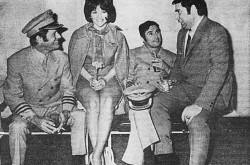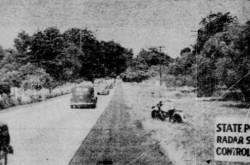Vous souvenez-vous de Joan Trefethen? Moi si, moi si!, Partie 1

Votre humble serviteur aimerait vraiment savoir si vous vous souvenez de Joan Trefethen, une pilote californienne que nous avons rencontrée dans un numéro de septembre de ce blog / bulletin / machin. Oui? Bien. Maintenant, vous souvenez-vous de son mari, Alfred « Al » Trefethen? Oui? Encore mieux, car il est un personnage principal de l’histoire qui est sur le point de se dérouler ici-même. Et oui, il y aura du contenu canadien.
Il était une fois, en 1948 plus précisément, quatre diplômés du Parks College avec un rêve. Cette institution du Missouri, la première école d’aéronautique américaine approuvée par le gouvernement fédéral, associée depuis un certain temps à Saint-Louis University, est connue en 2017 sous le nom de Parks College of Engineering, Aviation and Technology. Ces diplômés, dis-je, travaillent pour McDonnell Aircraft Corporation, un petit avionneur lui aussi basé à Saint-Louis. Ce sont George Allen Owl, Jr., Errol Painter et Robert Bruce « Bob » Short. Intéressés par la conception d’un aéronef bien à eux, ces passionnés d’aviation forment Parks Alumni Racebuilders Consortium, ou PAR, en septembre 1948.

The Parks Alumni Racebuilders Consortium PAR Special. Anon., “Have you seen?” Flying, February 1951, 35.
The single seat airplane that Owl designed, the PAR Special, was a Goodyear racer. In other words, it was a small, inexpensive but well designed racing airplane put together by a small team in order to take part in competitions initiated in 1946 by Goodyear Tire and Rubber Company, a giant in the American automobile industry. Such machines were commonly referred to as Formula 1 racers – an expression better known for its use in the world of automobile racing. Construction of the Special began in the spring of 1949. Test flown in January 1950, this very original, dare one say radical airplane took part in a number of races but did not prove very successful. It was broken up at some as yet undetermined date, possibly as early as 1952.
At some point in the 1960s, two homebuilders from California, in other words two individuals involved in the making of aircraft for their own personal use, acquired the wings, rear fuselage and tail of the Special. The aforementioned Trefethen and a friend, Harvey F. Mace, set out to design a single seat floatplane using these components. Thomas R. “Tom” Trefethen helped his father from time to time. The resulting machine was, you guessed it, the Mace-Trefethen Seamaster. The “Blue Bullet”, as it was also called, was completed in 1966. Floatation tests were carried out in the excavated tank visible in the photo at the start of this article – a photo found in the November 1967 issue of a visually very interesting American monthly magazine called Air Progress.
The as yet untested floatplane was briefly displayed in 1967, in Abbotsford, British Columbia, at the annual airshow held there since 1962. As you may know, this world class event was known in 2017 as the Abbotsford International Airshow. And yes, that’s the extent of the Canadian content for this issue of our blog / bulletin / thingee. The Seamaster then returned to the United States, in Washington, the state not the city to be more precise, to perform its first flight. After some satisfactory taxiing trials, a gust of wind pushed a wing tip into the water. Trefethen rushed out of the cockpit but fell in the Columbia River. It is possible that the Seamaster never actually flew.
This being said, one should not conclude that Mace and Trefethen were poor homebuilders. Between the late 1950s and the early 1980s, this dynamic duo designed and built at least four other aircraft, small racers from the looks of it. The earliest and latest of these were the M-101 Macerschmitt, also known as Could Be, named after a famous Second World War fighter, Germany’s Messerschmitt Bf 109 / Me 109, and the M-102 Scorchy. The R-1 Mr. B and R-2 Shark came out around 1969-70. And yes, the Canada Aviation and Space Museum, in Ottawa, Ontario, has a Bf 109 / Me 109 in its world class collection. And no, yours truly has no intention of pontificating about this machine at this particular point in the space time continuum. I will not even mention the change in name, in 1938, from Bayerische Flugzeugwerke Aktiengesellschaft to Messerschmitt Aktiengesellschaft, at the origin of one of the great quarrels in aviation history. Bf or not Bf, that is the question.
Yours truly initially thought that this article would end at this point. A chance discovery in the superb library of the Canada Aviation and Space Museum changed all that. We will therefore meet again very soon.

D’autres histoires par



















![Un bloc de photographies montrant quelques-unes des personnes impliquées dans le bombardement des bélugas de l’estuaire et du golfe du fleuve Saint-Laurent. Anon., « La chasse aux marsouins [sic]. » Le Devoir, 15 août 1929, 6.](/sites/default/files/styles/thumbnail_7/public/2024-09/Le%20Devoir%2015%20aout%201929%20page%206.jpg?h=584f1d27&itok=TppdLItg)












































































































































































































![Peter Müller aux commandes [sic] du Pedroplan, Berlin, Allemagne, mars 1931. Anon., « Cologne contre Marseille – Le mystère du ‘Pédroplan.’ [sic] » Les Ailes, 2 avril 1931, 14.](/sites/default/files/styles/thumbnail_7/public/2021-04/Les%20Ailes%202%20avril%201931%20version%20big.jpg?h=eafd0ed4&itok=WnBZ5gMf)












![Un des premiers de Havilland Canada Chipmunk importés au Royaume-Uni. Anon., « De Havilland [Canada] DHC-1 ‘Chipmunk.’ » Aviation Magazine, 1er janvier 1951, couverture.](/sites/default/files/styles/thumbnail_7/public/2021-01/Aviation%20magazine%201er%20janvier%201951%20version%202.jpg?h=2f876e0f&itok=DM4JHe5C)

























































































